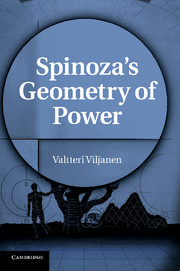Book contents
- Frontmatter
- Contents
- Acknowledgements
- Abbreviations
- Other sources
- Introduction
- Chapter 1 Spinoza on being
- Chapter 2 Causation and geometry
- Chapter 3 Power, existence, activity
- Chapter 4 The derivation of the conatus doctrine
- Chapter 5 The meaning of the conatus doctrine
- Chapter 6 Geometrical dynamics of individuality
- Conclusion
- Bibliography
- Index
Conclusion
Published online by Cambridge University Press: 07 October 2011
- Frontmatter
- Contents
- Acknowledgements
- Abbreviations
- Other sources
- Introduction
- Chapter 1 Spinoza on being
- Chapter 2 Causation and geometry
- Chapter 3 Power, existence, activity
- Chapter 4 The derivation of the conatus doctrine
- Chapter 5 The meaning of the conatus doctrine
- Chapter 6 Geometrical dynamics of individuality
- Conclusion
- Bibliography
- Index
Summary
From the preceding chapters emerges a philosophical position in which power and related notions have such a prominent place that it is fully justified, I think, to call Spinoza’s metaphysics dynamistic. To conclude, I would like to make some general observations about this metaphysics. We can begin by noting how such notions as striving, power of acting, desire, and essence work together to form an elaborate system of concepts with which Spinoza can theorize about human existence. For Spinoza, power is first and foremost a metaphysical concept that refers to things’ intrinsic capacity to cause effects; most importantly, the necessary realization of everything that follows from God’s essence requires power. As finite things express this power, they enter into causal relations with each other and are essential causers that never fail to bring about effects by their intrinsic power.
The notion of power had fallen to disrepute in Spinoza’s time, but Spinoza is determined to show that this was for no good reason. According to him, there is nothing occult in the intrinsic power things are endowed with; on the contrary, that power is exercised in the most intelligible way we can think of, with the kind of necessity that reigns in geometry. This is so because each thing has an internal structure most easily discernible in geometrical objects; that there is a certain register of variation an actual existent can undergo when under the varying influence of external causes – determined from eternity – does nothing to diminish the intelligibility and necessity involved. Indeed, as I hope to have shown, it is precisely on this that Spinoza founds his theory of human emotions designed to proceed in geometrical manner.
- Type
- Chapter
- Information
- Spinoza's Geometry of Power , pp. 177 - 180Publisher: Cambridge University PressPrint publication year: 2011

